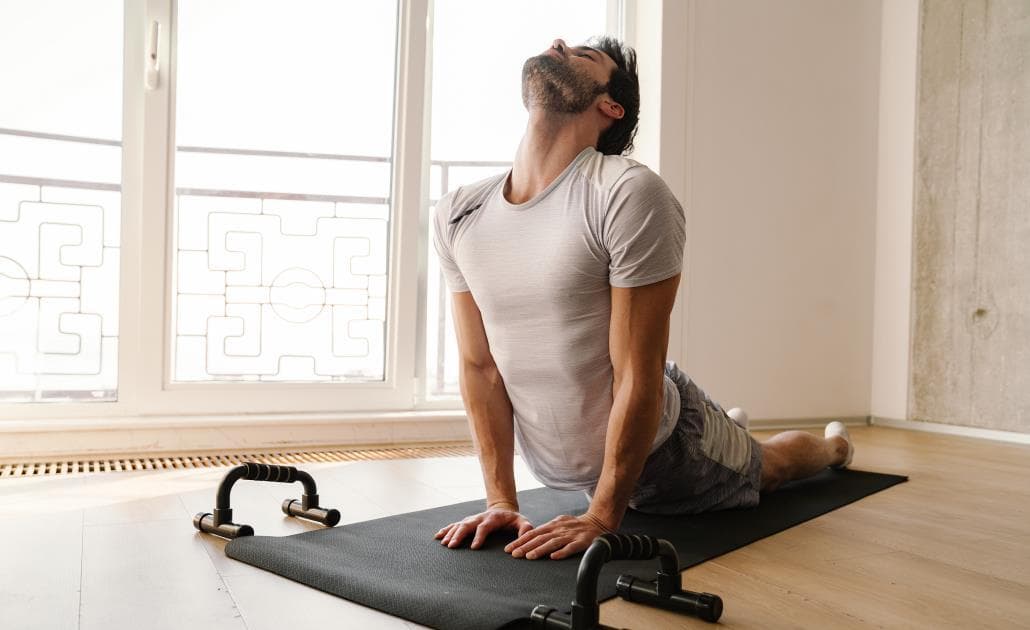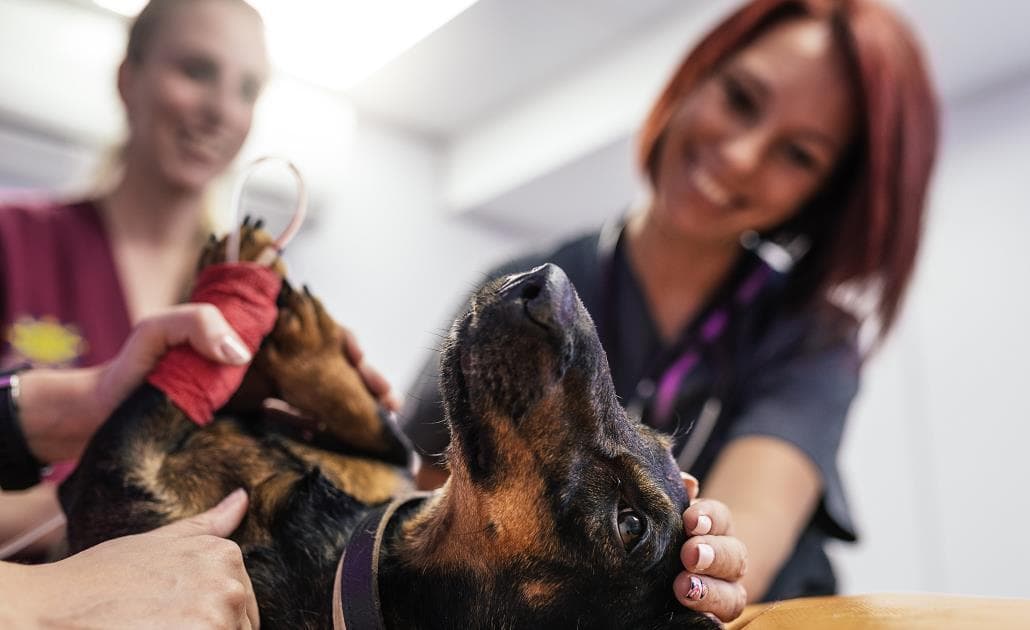
The day-to-day tasks of a veterinary technician are physically demanding. They spend long hours on their feet, lift and carry patients, and work at awkward angles, which can lead to occupational injuries if proper ergonomics aren't considered.
In this blog post, we will explore the world of veterinary ergonomics, understand its significance, and provide practical tips to help veterinary technicians protect their health on the job.
Key takeaways
Ergonomics is the study of how work environments can be optimized for human wellbeing.
Veterinary work is physically demanding and is associated with a range of health risks.
Understanding body mechanics, correctly configuring your workstation, and collaborating with your team can help keep you fit and healthy.
Understanding ergonomics in veterinary care
Ergonomics, often referred to as "the science of work," is the study of how work environments and tasks can be optimized for human wellbeing and performance. In the veterinary field, ergonomics is essential because it directly affects the health and longevity of veterinary technicians.
Occupational injuries in veterinary care
The physical demands of the job can take a toll on the body. Veterinary technicians are at risk of developing musculoskeletal disorders (MSDs) due to repetitive movements, poor posture, and overexertion. MSDs encompass a range of conditions, including back pain, neck pain, shoulder injuries, and carpal tunnel syndrome. These conditions can be debilitating, affecting not only the technician's quality of life but also their ability to provide excellent patient care.
Long-term benefits of ergonomics
Investing in ergonomic practices can yield long-term benefits. By prioritizing ergonomics in their daily routines, veterinary technicians can:
Prevent injuries: Implementing ergonomic principles can significantly reduce the risk of occupational injuries, allowing technicians to enjoy a healthier, pain-free career.
Improve efficiency: Ergonomically designed workspaces and processes can lead to increased efficiency, ultimately benefiting both the technician and the clinic.
Enhance patient care: When technicians are healthy and comfortable, they can provide better care to their animal patients.
Now that we understand the importance of veterinary ergonomics, let's dive into some practical tips to help veterinary technicians maintain good ergonomics and protect their health.
Proper body mechanics
Maintaining proper posture and body mechanics is fundamental to good ergonomics. Whether you're lifting a patient, assisting in surgery, or simply standing during an examination, here are some guidelines to keep in mind:
Standing posture
When standing, ensure that:
Your feet are hip-width apart for stability.
Your weight is evenly distributed between both feet.
You engage your core muscles to support your lower back.
You avoid locking your knees, as this can lead to discomfort and circulatory issues.
Sitting posture
If you have administrative tasks that require sitting, follow these tips:
Choose a chair that provides lumbar support and is adjustable in height.
Sit with your back against the chair's backrest and your feet flat on the floor.
Keep your knees at hip level or slightly below.
Use a footrest if necessary to support your feet.
Bending and reaching
When you need to bend or reach for something, remember to:
Bend at your hips and knees rather than your waist.
Keep the object you're reaching for close to your body.
Avoid twisting your back while lifting or reaching.
By incorporating these simple body mechanics into your daily routine, you can significantly reduce the strain on your muscles and joints, decreasing the risk of injuries.
Lifting and carrying patients

Patient handling is a significant part of a veterinary technician's job, and it can be physically demanding. Here are some guidelines for safe patient handling techniques:
Assess the situation
Before attempting to lift or carry a patient:
Evaluate the patient's size and condition.
Determine if you need assistance, such as another technician or a lift assist device.
Plan your approach and ensure a clear path to your destination.
Use proper lifting techniques
When lifting a patient:
Position yourself close to the patient with your feet shoulder-width apart.
Bend at your hips and knees to lower yourself to the patient's level.
Keep your back straight and maintain the natural curve of your spine.
Grip the patient securely and lift with your legs, not your back.
Teamwork is key
If a patient is too large or heavy for you to lift safely on your own, never hesitate to ask for help. Team lifting is not only safer but also ensures the wellbeing of both the patient and the technicians involved.
Utilize assistive devices
In cases where lifting is a frequent requirement, consider the use of assistive devices such as lifting slings, gurneys, or mechanical lifts. These tools can significantly reduce the physical strain associated with patient handling.
By following these guidelines, you can protect your back and musculoskeletal system while providing excellent care to your animal patients.
Equipment and workstation ergonomics
The design of your work environment can have a significant impact on your ergonomic comfort. Here's how you can optimize your equipment and workstation for better ergonomics:
Workstation setup
Ensure that your workstation is properly set up:
Adjust your chair and desk to the right height to maintain a neutral posture.
Use a monitor stand or an adjustable monitor arm to position your screen at eye level.
Place frequently used items within easy reach to minimize excessive stretching or twisting.
Exam tables and surgical areas
In veterinary care, exam tables and surgical areas are essential workspaces. To make them more ergonomic:
Choose exam tables and surgical tables with adjustable height options.
Use padded mats to reduce the impact on your feet and legs during lengthy procedures.
Keep surgical instruments and supplies well-organized and within reach to minimize excessive movements.
Adjustable equipment
Whenever possible, opt for equipment that allows for adjustments:
Use adjustable stools or chairs that support good posture.
Utilize adjustable microscope stands and surgical lights for precise positioning.
Consider specialized ergonomic tools designed for veterinary tasks.
By customizing your workspace and equipment to fit your specific needs, you can reduce the physical strain of your daily tasks and promote long-term wellbeing.
Stretching and exercise routine

While maintaining proper ergonomics during work is crucial, it's also essential to focus on your physical health outside of work hours. Incorporating stretching and exercise routines into your daily life can help prevent muscle strain and maintain your overall wellbeing.
Stretching exercises
Here are some stretching exercises tailored to the needs of veterinary technicians:
Neck stretch: Gently tilt your head to one side, holding for 15-30 seconds, and then switch sides.
Shoulder roll: Roll your shoulders backward and forward in a circular motion for 15-30 seconds.
Back stretch: Extend your arms forward, rounding your back, and hold for 15-30 seconds.
Calf stretch: Stand facing a wall, place one foot behind you with the heel on the ground, and press your hips forward to stretch the calf muscle. Hold for 15-30 seconds and switch sides.
Wrist flexor stretch: Extend your arm in front of you with your palm facing up, use your other hand to gently pull your fingers back toward your body, feeling the stretch in your forearm. Hold for 15-30 seconds and switch sides.
Quad stretch: Stand on one leg, bend your other knee, and gently pull your heel toward your buttocks to stretch the quadriceps muscle. Hold for 15-30 seconds and switch legs.
Hip flexor stretch: Kneel on one knee, keeping your other foot in front, and gently push your hips forward to feel the stretch in the hip flexor. Hold for 15-30 seconds and switch sides.
Ankle circles: Sit down and extend one leg. Rotate your ankle in a circular motion, both clockwise and counterclockwise, for 15-30 seconds each.
Exercise routine
Incorporate the following exercises into your routine to build strength and flexibility:
Core strengthening: Planks, leg raises, and bridges can help strengthen your core, providing better support for your back during tasks.
Aerobic exercise: Activities like walking, swimming, or cycling can improve cardiovascular health and overall fitness.
Yoga or pilates: These practices can enhance flexibility, balance, and muscle strength while promoting relaxation.
Remember to consult with a fitness professional or healthcare provider before starting any new exercise regimen, especially if you have pre-existing health conditions.
Footwear and apparel
Your choice of footwear and clothing can significantly impact your comfort and ergonomics. Here are some considerations:
Footwear
Selecting the right shoes is critical for your comfort and wellbeing:
Supportive shoes: Choose shoes with good arch support and cushioning to reduce foot fatigue. Look for options designed for all-day wear.
Proper fit: Ensure that your shoes fit well and provide adequate space for your toes. Avoid shoes that are too tight or too loose.
Replace worn-Out Shoes: Replace your shoes when they show signs of wear and tear, as worn-out footwear can lead to discomfort and musculoskeletal issues.
Orthotic inserts: If needed, consider using orthotic inserts to provide additional support and reduce strain on your feet and legs.
Socks and compression wear
Compression socks: Graduated compression socks or sleeves can help improve circulation and reduce leg fatigue. They are particularly useful if you spend long hours on your feet.
Moisture-wicking fabric: Choose socks made of moisture-wicking materials to keep your feet dry and comfortable throughout the day.
By investing in comfortable and supportive footwear and clothing, you can significantly enhance your day-to-day comfort and ergonomics in the veterinary clinic.
Ergonomics in administrative tasks
Administrative duties are an integral part of veterinary care, and they also require attention to ergonomics. Here's how you can create an ergonomic office setup:
Workstation setup
Follow the same principles for setting up your administrative workstation as you would for your clinical workspace. Ensure that your desk, chair, and computer monitor are adjusted to promote proper posture.
Keyboard and mouse ergonomics
Use an ergonomic keyboard and mouse that promote a neutral wrist position.
Position your keyboard and mouse at a height that allows your wrists to remain straight.
Consider using keyboard shortcuts to minimize repetitive mouse movements.
Monitor placement
Position your computer monitor at eye level to reduce strain on your neck and upper back.
Use monitor stands or adjustable monitor arms to achieve the correct height.
Regular breaks
Take short breaks every hour to stand up, stretch, and walk around. This can help prevent prolonged periods of sitting.
By paying attention to ergonomics in your administrative tasks, you can reduce the risk of developing conditions like carpal tunnel syndrome and maintain your overall health.
The role of teamwork and communication

Ergonomics is not solely an individual responsibility. Effective teamwork and communication among veterinary technicians play a crucial role in maintaining good ergonomics in the workplace:
Team lifting and assistance
Encourage teamwork when lifting heavy patients or equipment. Collaborating with colleagues can significantly reduce the risk of injury.
Use clear communication to coordinate movements during patient handling, ensuring that everyone is on the same page.
Ergonomic support from employers
Advocate for ergonomic support from your employer. This may include investing in ergonomic equipment, providing training on safe patient handling, and creating a culture of ergonomic awareness.
Communicate your ergonomic needs to your supervisors and managers. They may be able to implement changes that enhance the overall ergonomics of the clinic.
By working together and fostering a culture of ergonomic awareness, veterinary technicians can create a safer and more comfortable work environment.
Conclusion
In the fast-paced world of veterinary care, maintaining good ergonomics is not just a luxury; it's a necessity. By understanding the principles of ergonomics and implementing the tips provided in this blog post, veterinary technicians can protect their health, prevent occupational injuries, and continue to provide excellent care to their animal patients.
Remember that prioritizing ergonomics is an investment in your wellbeing and career longevity. By following proper body mechanics, optimizing your workspace, incorporating regular stretching and exercise, choosing the right footwear and apparel, and fostering teamwork and communication, you can enjoy a fulfilling and pain-free career in veterinary care.
Discover how Vet Radar can help you save time and strengthen your clinical processes. Book a demo today!